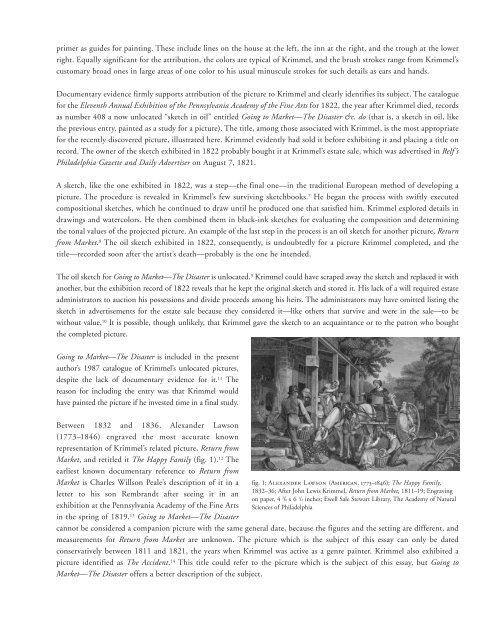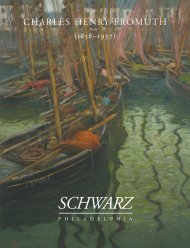pdf - Schwarz Gallery
pdf - Schwarz Gallery
pdf - Schwarz Gallery
You also want an ePaper? Increase the reach of your titles
YUMPU automatically turns print PDFs into web optimized ePapers that Google loves.
primer as guides for painting. These include lines on the house at the left, the inn at the right, and the trough at the lower<br />
right. Equally significant for the attribution, the colors are typical of Krimmel, and the brush strokes range from Krimmel’s<br />
customary broad ones in large areas of one color to his usual minuscule strokes for such details as ears and hands.<br />
Documentary evidence firmly supports attribution of the picture to Krimmel and clearly identifies its subject. The catalogue<br />
for the Eleventh Annual Exhibition of the Pennsylvania Academy of the Fine Arts for 1822, the year after Krimmel died, records<br />
as number 408 a now unlocated “sketch in oil” entitled Going to Market—The Disaster &c. do (that is, a sketch in oil, like<br />
the previous entry, painted as a study for a picture). The title, among those associated with Krimmel, is the most appropriate<br />
for the recently discovered picture, illustrated here. Krimmel evidently had sold it before exhibiting it and placing a title on<br />
record. The owner of the sketch exhibited in 1822 probably bought it at Krimmel’s estate sale, which was advertised in Relf’s<br />
Philadelphia Gazette and Daily Advertiser on August 7, 1821.<br />
A sketch, like the one exhibited in 1822, was a step—the final one—in the traditional European method of developing a<br />
picture. The procedure is revealed in Krimmel’s few surviving sketchbooks. 7 He began the process with swiftly executed<br />
compositional sketches, which he continued to draw until he produced one that satisfied him. Krimmel explored details in<br />
drawings and watercolors. He then combined them in black-ink sketches for evaluating the composition and determining<br />
the tonal values of the projected picture. An example of the last step in the process is an oil sketch for another picture, Return<br />
from Market. 8 The oil sketch exhibited in 1822, consequently, is undoubtedly for a picture Krimmel completed, and the<br />
title—recorded soon after the artist’s death—probably is the one he intended.<br />
The oil sketch for Going to Market—The Disaster is unlocated. 9 Krimmel could have scraped away the sketch and replaced it with<br />
another, but the exhibition record of 1822 reveals that he kept the original sketch and stored it. His lack of a will required estate<br />
administrators to auction his possessions and divide proceeds among his heirs. The administrators may have omitted listing the<br />
sketch in advertisements for the estate sale because they considered it—like others that survive and were in the sale—to be<br />
without value. 10 It is possible, though unlikely, that Krimmel gave the sketch to an acquaintance or to the patron who bought<br />
the completed picture.<br />
Going to Market—The Disaster is included in the present<br />
author’s 1987 catalogue of Krimmel’s unlocated pictures,<br />
despite the lack of documentary evidence for it. 11 The<br />
reason for including the entry was that Krimmel would<br />
have painted the picture if he invested time in a final study.<br />
Between 1832 and 1836, Alexander Lawson<br />
(1773–1846) engraved the most accurate known<br />
representation of Krimmel’s related picture, Return from<br />
Market, and retitled it The Happy Family (fig. 1). 12 The<br />
earliest known documentary reference to Return from<br />
Market is Charles Willson Peale’s description of it in a<br />
letter to his son Rembrandt after seeing it in an<br />
exhibition at the Pennsylvania Academy of the Fine Arts<br />
in the spring of 1819. 13 Going to Market—The Disaster<br />
fig. 1; Alexander Lawson (American, 1773–1846); The Happy Family,<br />
1832–36; After John Lewis Krimmel, Return from Market, 1811–19; Engraving<br />
on paper, 4 3 /8 x 6 1 /2 inches; Ewell Sale Stewart Library, The Academy of Natural<br />
Sciences of Philadelphia<br />
cannot be considered a companion picture with the same general date, because the figures and the setting are different, and<br />
measurements for Return from Market are unknown. The picture which is the subject of this essay can only be dated<br />
conservatively between 1811 and 1821, the years when Krimmel was active as a genre painter. Krimmel also exhibited a<br />
picture identified as The Accident. 14 This title could refer to the picture which is the subject of this essay, but Going to<br />
Market—The Disaster offers a better description of the subject.



